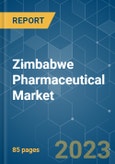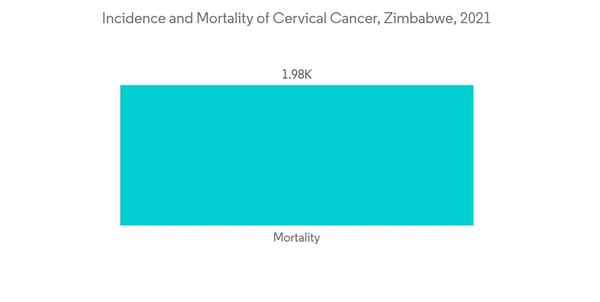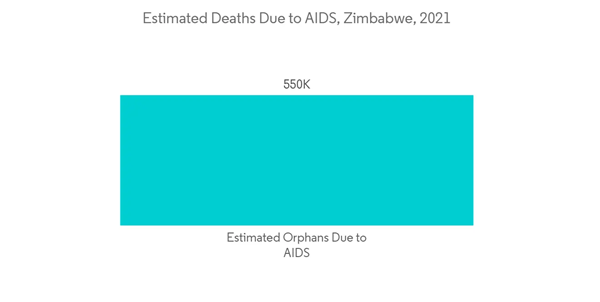The Zimbabwe pharmaceutical market is expected to register a CAGR of 4.3% over the forecast period.
The COVID-19 impact on the pharmaceutical industry in Zimbabwe was significant. The industry saw an increased demand for therapeutics to treat COVID-19-infected patients, which further led to an increase in the large-scale manufacturing of pharmaceutical products in the country. As the supply chain between the other regions of the world and Zimbabwe was disrupted due to lockdown measures, the local manufacturers played a critical role during the COVID-19 pandemic. For instance, according to a research article published in the Journal of Public Health International in May 2021, the disruption of medical supplies such as pharmaceuticals during the pandemic provided a great opportunity for Zimbabwe to be less dependent on foreign medical supplies, thereby increasing the local manufacturing of therapeutics. However, post-pandemic, the sector has been recovering well since supply chain restrictions were lifted. An increase in the supply of medication from global manufacturers and a rise in initiatives from the key market players, among others, have been leading the market recovery. Moreover, the Zimbabwean Ministry of Health and Child Care (MOHCC) took measures to strengthen the country's ability to produce medical supplies through various organizations such as Varichem, CAPS, Natpharma, and Avail Pharmaceuticals during the pandemic and is expected to impact the market's growth in post-pandemic phase. Thus, as per the analysis, the abovementioned factors significantly affected the market’s growth.
With an ageing population and rising rates of chronic disease, Zimbabwe's pharmaceutical sector is poised for expansion. According to the United Nations Population Fund report for 2022, the population aged 65 years and older in Zimbabwe was estimated at 3 million in 2022. The senior population is more likely to suffer from chronic conditions like cardiovascular disease, cancer, and gastrointestinal disorders, hence this demographic shift is predicted to boost the need for drugs in Zimbabwe.
Furthermore, in June 2021, the Zimbabwean government launched the 2021-2025 Pharmaceutical Manufacturing Strategy to improve the local production of drugs, thereby increasing the availability of the country's essential medicines and exporting excess drugs. In addition, in March 2021, the Republic of Zimbabwe became the 19th African Union (AU) Member State to sign the Treaty to establish the African Medicines Agency (AMA). This move may enable a favorable regulatory environment for pharmaceutical research and development, local production, and trade across countries on the African continent. Likewise, in April 2022, the University at Buffalo and the University of Zimbabwe entered a partnership to train future HIV researchers in Zimbabwe and received a USD 1.4 million grant from the National Institutes of Health (NIH). Such initiatives are expected to drive market growth over the forecast period.
Therefore, the demand for effective and novel therapeutics is expected to grow in the coming years. Thus, the abovementioned factors are anticipated to aid the market's growth over the forecast period. However, the stringent regulatory framework is expected to restrain the growth.
The prevalence of chronic diseases such as cancers is increasing in Zimbabwe, thus boosting the demand for advanced therapeutics and driving the market segment due to the affordability of these drugs. As an example, the Zimbabwe Human Papillomavirus and Related Cancers Fact Sheet 2021 reports that there are 3,043 new instances of cervical cancer in Zimbabwe per year. The high rate of cervical cancer in the country is likely to raise the consumption of generic medications, which could boost demand within the predicted time frame.
Furthermore, in November 2022, the deputy minister of health and child care of zimbabwe urged pharmaceutical firms to encourage the manufacturing of generic medications in order to lower the cost of the nation's medical imports. Such initiatives will lead to increased production of generic drugs, thereby lead to increased adoption, driving the segment growth.
Therefore, owing to the above-mentioned factors, the generic drugs segment is expected to grow over the forecast period.
According to the CDC, in 2021, the estimated prevalence of HIV in Zimbabwe among the 15-49 year age group was found to be 11.6%, and the number of adults above the age of 15 on antiretroviral therapy in 2021 was 1,136,246. Therefore, the huge prevalence of HIV and the dependence on antiviral therapy are expected to drive segment growth over the forecast period.
Furthermore, the rising approvals of antiinfective drugs in Zimbabwe are expected to drive the segment's growth. For instance, in October 2021, the Medicines Control Authority of Zimbabwe approved three private hospitals and three private pharmacies to dispense Ivermectin, a broad-spectrum anti-parasitic drug, for the prevention and treatment of COVID-19. Therefore, increasing approvals from the government of Zimbabwe are expected to drive the growth of this segment.
Thus, the rising infectious diseases and the rising approvals for anti-infective therapies are likely to boost the segment's growth over the analysis period.
This product will be delivered within 2 business days.
The COVID-19 impact on the pharmaceutical industry in Zimbabwe was significant. The industry saw an increased demand for therapeutics to treat COVID-19-infected patients, which further led to an increase in the large-scale manufacturing of pharmaceutical products in the country. As the supply chain between the other regions of the world and Zimbabwe was disrupted due to lockdown measures, the local manufacturers played a critical role during the COVID-19 pandemic. For instance, according to a research article published in the Journal of Public Health International in May 2021, the disruption of medical supplies such as pharmaceuticals during the pandemic provided a great opportunity for Zimbabwe to be less dependent on foreign medical supplies, thereby increasing the local manufacturing of therapeutics. However, post-pandemic, the sector has been recovering well since supply chain restrictions were lifted. An increase in the supply of medication from global manufacturers and a rise in initiatives from the key market players, among others, have been leading the market recovery. Moreover, the Zimbabwean Ministry of Health and Child Care (MOHCC) took measures to strengthen the country's ability to produce medical supplies through various organizations such as Varichem, CAPS, Natpharma, and Avail Pharmaceuticals during the pandemic and is expected to impact the market's growth in post-pandemic phase. Thus, as per the analysis, the abovementioned factors significantly affected the market’s growth.
With an ageing population and rising rates of chronic disease, Zimbabwe's pharmaceutical sector is poised for expansion. According to the United Nations Population Fund report for 2022, the population aged 65 years and older in Zimbabwe was estimated at 3 million in 2022. The senior population is more likely to suffer from chronic conditions like cardiovascular disease, cancer, and gastrointestinal disorders, hence this demographic shift is predicted to boost the need for drugs in Zimbabwe.
Furthermore, in June 2021, the Zimbabwean government launched the 2021-2025 Pharmaceutical Manufacturing Strategy to improve the local production of drugs, thereby increasing the availability of the country's essential medicines and exporting excess drugs. In addition, in March 2021, the Republic of Zimbabwe became the 19th African Union (AU) Member State to sign the Treaty to establish the African Medicines Agency (AMA). This move may enable a favorable regulatory environment for pharmaceutical research and development, local production, and trade across countries on the African continent. Likewise, in April 2022, the University at Buffalo and the University of Zimbabwe entered a partnership to train future HIV researchers in Zimbabwe and received a USD 1.4 million grant from the National Institutes of Health (NIH). Such initiatives are expected to drive market growth over the forecast period.
Therefore, the demand for effective and novel therapeutics is expected to grow in the coming years. Thus, the abovementioned factors are anticipated to aid the market's growth over the forecast period. However, the stringent regulatory framework is expected to restrain the growth.
Zimbabwe Pharmaceutical Market Trends
The Generic Drugs Segment Holds a Significant Share and is Expected to Continue the Trend During the Forecast Period
The major driving factors for the generic drugs segment are the rising initiatives by key players, the launch of new products aimed at treating various illnesses, the growing geriatric population, the rising prevalence of chronic diseases such as cardiovascular diseases, cancers, and autoimmune diseases, and the growing awareness about the use of prescription drugs in the country. In addition, according to the study published in Therapeutic Innovation & Regulatory Science in January 2021, more than 80% of the drugs sold in Zimbabwe are generic drugs.The prevalence of chronic diseases such as cancers is increasing in Zimbabwe, thus boosting the demand for advanced therapeutics and driving the market segment due to the affordability of these drugs. As an example, the Zimbabwe Human Papillomavirus and Related Cancers Fact Sheet 2021 reports that there are 3,043 new instances of cervical cancer in Zimbabwe per year. The high rate of cervical cancer in the country is likely to raise the consumption of generic medications, which could boost demand within the predicted time frame.
Furthermore, in November 2022, the deputy minister of health and child care of zimbabwe urged pharmaceutical firms to encourage the manufacturing of generic medications in order to lower the cost of the nation's medical imports. Such initiatives will lead to increased production of generic drugs, thereby lead to increased adoption, driving the segment growth.
Therefore, owing to the above-mentioned factors, the generic drugs segment is expected to grow over the forecast period.
General Anti-infective Systemic Segment is Expected to Hold a Significant Share in the Market
The factors driving the growth of this segment include the rising prevalence of infectious diseases such as HIV, HPV, and TB and the rising launch of drugs for infectious diseases, among others.According to the CDC, in 2021, the estimated prevalence of HIV in Zimbabwe among the 15-49 year age group was found to be 11.6%, and the number of adults above the age of 15 on antiretroviral therapy in 2021 was 1,136,246. Therefore, the huge prevalence of HIV and the dependence on antiviral therapy are expected to drive segment growth over the forecast period.
Furthermore, the rising approvals of antiinfective drugs in Zimbabwe are expected to drive the segment's growth. For instance, in October 2021, the Medicines Control Authority of Zimbabwe approved three private hospitals and three private pharmacies to dispense Ivermectin, a broad-spectrum anti-parasitic drug, for the prevention and treatment of COVID-19. Therefore, increasing approvals from the government of Zimbabwe are expected to drive the growth of this segment.
Thus, the rising infectious diseases and the rising approvals for anti-infective therapies are likely to boost the segment's growth over the analysis period.
Zimbabwe Pharmaceutical Market Competitor Analysis
The Zimbabwe pharmaceutical market is highly competitive and consists of several major players. In terms of market share, a few major players are currently dominating the market. Some prominent players are vigorously making acquisitions and joint ventures with other companies to consolidate their market positions in the country. Some of the companies in this market include DatLabs (Pvt) Ltd., Pharmanova, CosPharma, Zim Laboratories Limited, and B. Braun SE, among others.Additional benefits of purchasing the report:
- The market estimate (ME) sheet in Excel format
- 3 months of analyst support
This product will be delivered within 2 business days.
Table of Contents
1 INTRODUCTION
4 MARKET DYNAMICS
5 MARKET SEGMENTATION (Market Size by Value - USD million)
6 COMPETITIVE LANDSCAPE
Companies Mentioned (Partial List)
A selection of companies mentioned in this report includes, but is not limited to:
- Datlabs (Pvt) Ltd
- Pharmanova
- GlaxoSmithKline PLC
- Zim Laboratories Limited
- National Pharmaceutical Company (NatPharm)
- CosPharma
- Viatris Inc.
- Caps (Pvt) Ltd.
- B.Braun SE
Methodology

LOADING...










